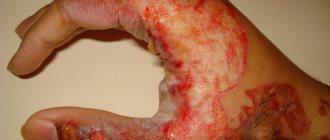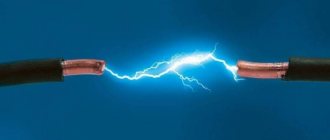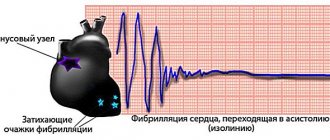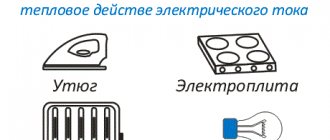The first mention of electricity dates back to the 4th century BC in the works of the Greek philosopher Aristotle, and in the 5th century BC. e., the scientist Thales of Miletus mentioned this phenomenon in his works. Subsequently, until the 17th century, no mention of electricity was recorded in the history of mankind. At the end of the 18th century, the influence of electric current on the human body was first mentioned, but at that time scientists still knew little about the danger that current poses to humans.
Return to content
The effect of electric current on the human body
Current, unlike other hazardous media, is colorless, odorless, and invisible.
Electric current has the following types of effects on the human body: thermal, electrolytic, biological. Let's look at each of these impacts in more detail.
The thermal effect consists of burns to areas of the body, heating of blood vessels and nerve endings. This type of action is also called thermal. Because thermal energy obtained from electrical energy creates burns.
Electrolytic exposure leads to the decomposition of blood and other fluids in the body through the process of electrolysis, which causes disturbances in the physico-chemical composition of these fluids. The essence of the damage comes down to the molecular level - thickening of the blood, changes in the charge of proteins, steam and gas formation in the body.
The biological effect of electric current on the body is accompanied by irritation and excitation of organs. This causes spasms and contractions.
In the case of the heart and lungs, this effect can be fatal due to the cessation of respiratory and cardiac function.
Biological effects cause mechanical damage to human organs and joints. Mechanical damage can also be caused by a person falling from a height due to exposure to electric current.
Biological and mechanical effects
The degree of damage can vary and leaves its mark on living tissue. Current can leave thermal, electrolytic, mechanical and biological “imprints”. Usually it is the last 2 categories that are distinguished.
The mechanical, or as it is also called dynamic, effect of electric current is determined by the delamination and rupture of various tissues. This affects mainly muscle and lung tissue, and the walls of blood vessels in the circulatory system. This happens under the influence of an electrodynamic effect, as well as the instantaneous explosive formation of steam from superheated tissue fluid and blood.
The biological effect of electric current on the human body can be understood by the activation of living tissues and a change in their functionality. Additionally, there is a disruption of internal bioelectric processes, which up to this point were proceeding normally. This work directly affects viable functions. The biological effects of current in this interpretation are considered to be of a very dangerous type.
Additional Information ! Determining the type of exposure can help guide the treatment process.
Thermal - gives itself away as burns in certain areas of the body. Blood vessels, nerve endings, heart, brain and other organs are heated to very high temperatures. Such overheating causes serious disorders of tissue functions. Organic fluid decomposes, namely lymph, blood, and cellular fluid.
Thermal damage
This is accompanied by significant disturbances in body fluids and its physical properties. Many changes occur in the chemical composition.
What reasons influence the consequences after an electric shock?
There are several routes for current to travel through the body. Depending on this scheme, an electrocardiogram is determined, which determines the sign of coronary insufficiency, and morphological studies show the presence of a sign of myocardial infarction.
Note ! Such data are confirmed by numerous clinical observations and analyses.
A person who has suffered an electrical injury, even if he feels normal, cannot be left without medical supervision. The victim should be hospitalized for 3 days under the category of “potentially seriously ill.”
Disruption of body systems
Even after a long-standing incident, there were cases when the victim began to develop diabetes, thyroid disease and reproductive system disease. Diseases such as allergies, persistent negative changes in the functioning of the cardiovascular system and autonomic-endocrine disorders may also occur.
Cases of delayed complications have been recorded in history. These were mainly mental problems (schizophrenia, psychoneuroses). For several years (months) after the event, some people developed cataracts. Victims who have been in an electrical circuit often experience unexpected bleeding even at the time of treatment.
People whose work involves electric current develop the following chronic diseases:
- Super early arteriosclerosis.
- Endarteritis.
- Disorders of the autonomic system.
Electric shock
The consequences of old electrical injuries in most cases appear many years after the incident. It turns out that the effect of electric current is not without its consequences. This often leads to decreased ability to work, suppressed body functions, and the acquisition of chronic diseases.
This essence of the effect of electric current on the human body has statistical indications. In the first month, 30% of victims already experience results; in 15%, this occurs after six months.
Short circuit (SC)
It can be imagined as a situation where the conductors of a wire or cable in an electrical network are short-circuited to each other. Such an accident is accompanied by the appearance of currents that can reach hundreds and even thousands of amperes and is one of the most destructive phenomena. The main consequence of a short circuit is the heating of all elements of the electrical network, which can lead to their failure and even destruction, but still the main danger is the risk of a fire. That is why it is important to have protective devices in the electrical network that will not only detect a short circuit in time, but also guarantee that it will be turned off as quickly as possible before the consequences become irreversible.
Threshold palpable, non-releasing and fibrillation currents
The degree of danger of electric current affecting a person depends on its value. An electric current that causes tangible irritation when passing through the human body is called tangible current , and the smallest value of this current is called threshold tangible current .
A person begins to feel the impact of a small current passing through him: on average, about 1.1 mA with alternating current with a frequency of 50 Hz and about 6 mA with direct current. This effect with alternating current is manifested by mild itching and slight tingling (tingling), and with direct current, a feeling of heating of the skin in the area touching the current-carrying part.
A threshold perceptible current cannot cause injury to a person, but prolonged (several minutes) passage of this current through a person can adversely affect his health. In addition, a noticeable current can become an indirect cause of an accident, since a person, having felt the effects of electric current, loses confidence in his safety and may perform incorrect actions. Unexpected exposure to significant current is especially dangerous when working near live parts at height and in other similar conditions.
An electric current that, when passing through a person, causes irresistible convulsive contractions of the muscles of the arm in which the conductor is clamped is called non-releasing current , and its smallest value is the threshold non-releasing current . Threshold non-releasing currents are different for men, women and children. Their approximate average values are: for men - 16 mA at 50 Hz and 80 mA at constant current, for women - 11 and 50 mA, respectively, for children - 8 and 40 mA.
Fibrillation current is an electrical current that causes fibrillation of the heart as it passes through the body. Its smallest value is called threshold fibrillation current . An electric current of 50 mA or more at 50 Hz, passing through the human body, spreads its irritating effect to the muscles of the heart, thereby causing it to contract chaotically and stop.
At a frequency of 50 Hz, fibrillation currents range from 50 mA to 5 A, and the average value of the threshold fibrillation current can be considered 300 mA. A current greater than 5 A, either alternating or direct, causes immediate cardiac arrest, bypassing the state of fibrillation.
The basis for organizing the safe operation of electrical installations is high technical literacy and conscious discipline of maintenance personnel, who are obliged to strictly observe special organizational and technical measures, rules and regulations for safe work in existing electrical installations, as well as techniques and sequence of operational operations.
Electric current from 0.5 to 1.5 mA
A person will definitely feel the impact of the passing current if its strength is 0.6-1.5 mA. This indicator is determined by the threshold perceptible type. It does not pose a significant danger. A person without the help of others can interrupt contact with a source of electric current.
Minor indicators
This is a slight effect of electric current, which is manifested by a slight tingling or tingling sensation.
Power 15 mA
With a current strength of 10-15 mA, a person is no longer able to take his hand off the electrical wires or break the circuit. Such a current is conventionally called “non-releasing current”. This value provokes contraction of the muscles of the hand and forearm. The pain is significant. As a result, the victim cannot throw away the wire. The duration of this action may cause changes in the body.
Power above 25mA
A current of 50 mA provokes damage to the respiratory and circulatory system. At 100 mA, cardiac fibrillation occurs - the organ stops its work, blood circulation stops.
Electricity
The electrolytic effect of current on the human body is expressed in the form of sudden cardiac arrest and respiratory paralysis.
Causes of Electrical Damage
Many causes of electrical injuries are very banal - absent-mindedness of the victim himself. Damage occurs as a result of incorrect current supply and power surges. The reason may be poor insulation or direct contact with electrical installations without first disconnecting.
The causes of electric shock can be systematized as follows:
- technical - faulty equipment;
- organizational - safety precautions are not followed;
- psychophysiological - severe fatigue, inattention.
Most injuries occur at work. As a result of examining each case, it was noted that people are more often injured at the end and beginning of a work shift. Electric shocks often occur during workers' morning shifts. At the end of work, attentiveness decreases and severe fatigue develops. But the frequency of morning injuries is explained by the peculiarity of the work order: most work with electrical installations occurs at the beginning of the shift.
Environmental impact.
The environment can in many cases influence the risk of electric shock to a person. Factors of this influence include atmospheric pressure, temperature, humidity, electric or magnetic fields, etc.
An increase in air temperature affects a person's sweating, as a result of which the electrical resistance of his body drops and the danger of electric shock increases.
Similar phenomena are also associated with high humidity. Here there is a decrease not only in electrical resistance, but also in the body’s overall resistance to electric current.
The influence of these two factors, temperature and humidity, is recorded in regulatory documents.
The third atmospheric factor, ambient air pressure, also affects sensitivity to electric current. As the pressure increases, the risk of injury decreases. For example, statistics show that no fatal or severe electrical injuries have been recorded during underwater electric welding, although cases of contact of divers working underwater with live elements and contacts have been noted repeatedly.
The opposite picture was established for low atmospheric pressure, which is especially significant in connection with the electrification of mountainous areas. It has been experimentally proven that low atmospheric pressure increases the danger of electric current for living organisms.
Types of electric shock
Electrical injury is an injury caused by exposure to an electric current or electric arc. This variety of effects of electric current on the body often leads to various electrical injuries, which come down to two types:
- Local electrical injuries, when local damage to the body occurs;
- General electrical injuries, so-called electric shocks, when the entire body is affected due to disruption of the normal functioning of vital organs and systems.
Local electrical injury is a pronounced local violation of the integrity of body tissues caused by exposure to electric current or electric arc. The danger of local electrical injuries and the complexity of their treatment depend on the location, nature and extent of tissue damage, as well as on the body’s response to this damage. As a rule, local electrical injuries are cured, and the victim’s ability to work is fully or partially restored.
Typical local electrical injuries are electrical burns, electrical marks, skin metallization, mechanical damage and electroophthalmia.
- Electrical burns are divided into current (contact) and arc.
- Electrical marks , also called current signs or electrical marks, are sharply defined spots of gray or pale yellow color on the surface of the body of a person who has been exposed to an electric current.
- Metallization of the skin is the penetration into the upper layers of the skin of the smallest particles of metal melted under the action of an electric arc.
- Mechanical damage is in most cases the result of sharp involuntary convulsive muscle contractions under the influence of current passing through the human body. As a result, ruptures of tendons, skin, blood vessels and nerve tissue, and joint dislocations can occur. Of course, injuries caused by falling from a height, bruises on objects, etc. are not considered electrical injuries. as a result of exposure to current.
- Electroophthalmia (from the Greek ophthalmos - eye) is an inflammation of the outer membranes of the eyes - the cornea and conjunctiva (the mucous membrane covering the eyeball), resulting from exposure to a powerful stream of ultraviolet rays, which are vigorously absorbed by the body's cells and cause chemical changes in them. Such irradiation is possible in the presence of an electric arc, which is a source of intense radiation not only of visible light, but also of ultraviolet and infrared rays.
- Electric shock is the excitation of living tissues of the body by an electric current flowing through it, manifested in involuntary convulsive contractions of various muscles of the body.
The outcome of the effect of electric current on the human body depends on a number of factors, including the value and duration of the current passing through the body, the type and frequency of the current, as well as the individual properties of the person. An electric shock, even if it does not lead to death, can cause serious disorders in the body that appear immediately or after a certain time.
As a result of an electric shock, cardiovascular diseases (cardiac arrhythmia, angina, blood pressure disorders, etc.), as well as nervous diseases (neurosis, endocrine disorders, etc.) may arise or worsen.
Electric shock
Electric shock is an extreme reaction of the body to the effects of electric current; during shock, severe disorders of all organs and systems develop. At first, excitement develops when a person does not feel pain and seems to be fine, but there is no need to rejoice because then inhibition sets in when the nervous system “switches off”, blood pressure drops and the pulse becomes frequent, consciousness is depressed, the person does not respond to external stimuli .
The state of shock can last, depending on the functional capabilities of the body, from several minutes and last several days. After a critical period, gradual recovery or death may occur. It all depends on the treatment performed and first aid provided correctly.
By type of contact
Damages may be:
- contact - there is direct contact of electricity with the human body, the current directly passes through its tissues,
- non-contact or arc - injury occurs when a person is exposed to an electric arc; as such, the passage of current through the body does not occur,
- mixed - the impact of both traumatic factors is combined.
By type of receipt
Depending on the method of receipt, electrical burns are divided as follows:
- household - a person receives them at home. Most often they are mild and do not pose a serious threat to life,
- natural - lightning burns are considered the most dangerous, few people survive after them,
- industrial ones are among the most serious, since enterprises use enormous voltage current.
Increase in voltage above permissible values
One of the common causes of failure of household electrical devices is an increase in voltage above permissible values. The statistics are relentless - reports of burnt-out refrigerators, televisions and other equipment appear periodically and the cause is usually voltage fluctuations. What is the reason for such phenomena? To understand the reasons for the increase in voltage, it is worth saying a few words about what voltages operate in a 3-phase electrical network.
So, in a 3-phase network there are 2 types of voltage: linear - the voltage between two phases and phase, this is the voltage between the phase and the working neutral conductor (it is also often called “zero” or “neutral”). Accordingly, the linear voltage is 380 V, the phase voltage is 220 V. In a household electrical network, we use phase voltage, but if the neutral conductor breaks (the so-called “zero break”), this voltage can reach 1.73 * phase voltage, or 380 V. Thus Thus, the devices connected to the network at this moment will be under voltage for which they are not designed and will be disabled or, even worse, will catch fire and can cause a fire.
A device called a voltage relay can protect equipment in your home from such dangers. This is a compact network protective element that is installed in the electrical panel and monitors the voltage in the network. As soon as the voltage exceeds a predetermined threshold, the device turns off a section of the network, but remains turned on. Once the voltage returns to normal, the voltage relay will turn the power back on. In this way, the voltage relay helps protect connected equipment from damage.
Degrees of electrical burns
There are several degrees of severity of electrical damage to a person:
- First. The mildest, accompanied by slight redness and swelling of the skin. After properly provided first aid, treatment can be continued at home.
- Second. Involves deeper tissue damage with the formation of blisters. The victim feels severe pain. Treatment usually takes place at home, but under the supervision of a doctor.
- Third. It is characterized by skin necrosis and the formation of blisters with bloody contents. If, after opening the blisters, the red wound surface is exposed, this indicates a favorable prognosis with adequate therapy. If the skin becomes dark and does not hurt, we can assume complete tissue death with no prospect of recovery.
- Fourth. Necrosis occurs of both the skin itself and subcutaneous fatty tissue, muscles, and bone tissue. In this case, only emergency medical intervention will save a person’s life.
Electrical safety, home experiments with electricity
Each of us, of course, had to screw in a light bulb, repair a burnt cord on an iron, or tighten the contacts in a socket. In this case, it is not at all necessary to have a special electrical engineering education. In much the same way as it is not necessary to know down to the smallest detail the structure of an internal combustion engine in order to become a car enthusiast. Minor faults can be eliminated without knowing the whole car as a whole, but in serious cases you can always contact a car service. It’s exactly the same with electricity: it’s absolutely not necessary to invite an electrician from the housing office to replace a faulty switch or socket. But at the same time, you need to know why electricity is dangerous, and what rules must be followed so as not to forever lose the desire for such work. After all, you must admit, it’s not at all fun to sit all day and wait for a good uncle to come and click on a switched off machine or RCD, because you are afraid to do it yourself or simply don’t know about it.
Of course, to carry out serious electrical work you will need a whole set of tools, but first you should get acquainted with the basics of electricity, and also remember about electrical safety.
Classification of premises in relation to the danger of electric shock
Depending on certain conditions that increase the danger of exposure to electric current on a person, different rooms have different degrees of danger of electric shock - some are greater, others are less. In accordance with the Electrical Installation Rules, premises with respect to the danger of electric shock to people are classified as follows:
1. Premises without increased danger , in which there are no conditions that create increased or special danger. In such rooms, the relative air humidity is less than 60%, there is no high temperature, conductive dust, chemically active or organic environment, conductive floors, and the possibility of simultaneous contact with the metal structures of buildings, apparatus, mechanisms and metal casings of electrical equipment.
2. Premises with increased danger , characterized by the presence of one of the following conditions creating an increased danger:
- dampness (relative humidity more than 75%) or conductive dust;
- conductive floors (metal, earthen, reinforced concrete, brick, etc.);
- high temperature (temperature constantly or periodically (more than one day) exceeds 35°C);
- the possibility of simultaneous human contact with metal structures of buildings connected to the ground, with technological devices, mechanisms, etc., on the one hand, and with metal casings of electrical equipment (exposed conductive parts) on the other.
3. Particularly dangerous premises , characterized by the presence of one of the following conditions creating a particular danger:
- special dampness (relative air humidity is close to 100% - the ceiling, walls, floor and objects in the room are covered with moisture);
- chemically active or organic environment (rooms containing aggressive vapors, gases, liquids, deposits and mold that destroy insulation and live parts of electrical equipment);
- two or more high-risk conditions at the same time.
In terms of the danger of electric shock to people, the territory of open electrical installations is equated to especially dangerous premises.
First aid rules
To properly provide first aid to the victim, you need to adhere to the following algorithm:
- It is very important to stop the impact of the traumatic factor as quickly as possible. It is necessary to open the circuit by unplugging the plug from the socket, moving the electrical wire away with a wooden object, or simply dragging the person away from the power source. At the same time, it is important to take care of your own safety. It is strictly forbidden to step on water or touch the victim with bare hands .
- If the person is conscious, you need to ask him in detail about his state of health and immediately call an ambulance.
- If the victim has lost consciousness, it is necessary to check for signs of life - breathing, pulse. If they are absent, you should immediately begin resuscitation measures - chest compressions and artificial ventilation.
- The person's torso should be higher than the head. It is advisable to place a cushion of clothing, a blanket or any other available materials under your feet.
- Before doctors arrive, you should carefully examine the victim’s body for visible injuries.
- It is advisable to find places of burns - entrance and exit zones. They must be covered with a sterile bandage to prevent infection.
Introduction
Electricity has become part of our everyday life so long ago that it seems as if it was discovered at the time of the invention of the wheel, or maybe even earlier. The popularity of using electrical energy is very simple to explain: it is electricity that powers various mechanisms and machines, electric vehicles and all kinds of household appliances. It helps to facilitate various work and organize leisure time: remember how much time we spend in front of the TV, computer or home theater. At the same time, electricity is not noticeable, does not make noise, and has no color or smell.
It can only be detected with the help of instruments; in the simplest case, such a device is an ordinary light bulb or an indicator screwdriver. But often this “invisibility” can turn electricity from a good helper into an evil enemy, from creative energy into destructive, and sometimes even deadly. Moreover, unsuccessful experiments with electricity can cause fear of such work for life.










